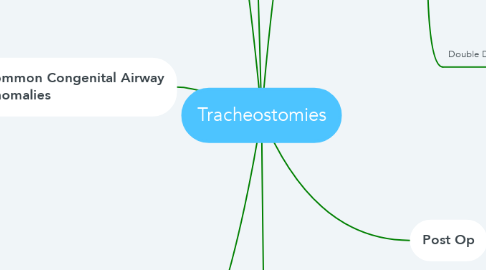
1. Common Congenital Airway Anomalies
1.1. Diagnostic Evaluation
1.1.1. CT Scan
1.1.2. MRI
1.1.3. Flexible Fiberscope
1.1.4. SpO2
1.1.5. Anterior Posterior (AP) and Lateral X ray
1.1.6. UGI
1.2. Types
1.2.1. Laryngomalacia
1.2.1.1. weak to stay open
1.2.2. Transesoesophageal Fistula
1.2.2.1. suppose to be divided
1.2.3. Laryngeal Cyst
1.2.3.1. mass
1.2.4. Subglottic Stenosis
1.2.4.1. straw
1.3. Signs and Symptoms
1.3.1. Voice Abnormalities
1.3.2. Aspiration
1.3.3. Cough
1.3.4. FTT
1.3.5. Think low O2
2. Speech
2.1. 1 way speak valve
2.2. unconscious-uncuff and deflate
2.3. Passy Muir
2.3.1. not when sleep, cuffed trach or unmanageable secretiosn
2.4. uncuff needs to be small enough to exhale
2.5. large air leak if can vocalize when need a bigger or cuffed trach
3. Humidification
3.1. nose natural clean and warms
3.2. trach collar system
3.3. HME= Heat moisture Exchange ariticial nose
3.4. vent circuits
4. Emergency Supplies
4.1. single cannula
4.1.1. same size
4.1.2. 1/2 size small NEO or PED
4.1.3. 1 size smaller adult
4.2. dual cannula
4.2.1. same size
4.2.2. size smaller
4.2.3. extra cannu;a
5. Brands
5.1. Bivona
5.1.1. Types
5.1.1.1. Hyperflex
5.1.1.2. NEO
5.1.1.3. Flextend
5.1.1.4. PED
5.1.2. TTS- Tight to Shaft
5.1.3. Water inflatable
5.1.4. MRI Conditional
5.1.5. silicone and soft
5.1.6. temperature not affects
5.2. Shiley
5.2.1. Types
5.2.1.1. PED
5.2.1.2. PLC- Pedatric Long Cuff
5.2.1.3. NEO
5.2.2. Air Inflatable
5.2.3. old model bulky
5.2.4. new model soft and flat
5.2.5. PVC- polyvinyl Chloride softens with heat adjust to patients neck
5.3. Single
5.4. Double Dual
5.4.1. inner cannula
5.4.2. older kids
5.4.3. change once a month
5.4.4. air cuff
5.4.5. Change inner cannula daily
6. Post Op
6.1. sutures for 5-7 days
6.2. sutures around trach and to cartilage
6.3. Surgeon does first trach change 5-7 days post op
6.4. secure to chest if comes out really hard to put back in one stings both sides
7. Size
7.1. Width
7.1.1. OD
7.1.1.1. Outer Diameter
7.1.1.2. limits to upsizing trach r/t stoma size
7.1.1.3. too big= stoma break down internal granuloma
7.1.1.4. too small= air leak
7.1.2. no >2/3-3/4 width of trach
7.1.3. ID
7.1.3.1. Inner Diameter
7.1.3.2. this is what referred to for size
7.1.3.3. helps ventilation/.sucitoning
7.1.3.4. avoid too much pressure on wall to big trach
7.2. Length
7.2.1. T2 - T3
7.2.2. 1-2 cm above carina
7.2.3. 3.5 NEO to 3.5 PEDI length difference
7.2.4. longer trach if keeps flipping out
7.3. Upsizing
7.3.1. risk for false passage
7.3.1.1. concern with to big of trach for airway granulation in airway
7.3.2. upsize 1 at a time
7.3.3. 3.0 to 3.5 not 3.0 to 4.0
7.3.4. stoma needs to stretch
7.3.5. Some kids no upsizing
